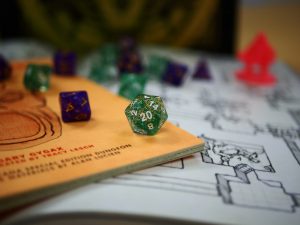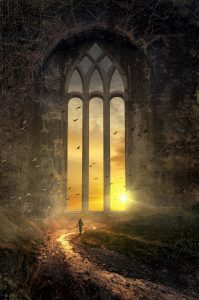Photo by Clint Bustrillos on Unsplash
Table of Contents
- TL;DR Explanation: What are Tabletop RPGs?
- How Do You Play a Tabletop RPG?
- What Do You Need to Play?
- What Kinds of Tabletop RPGs Can You Play?
- Are Tabletop RPGs Fun?
- Wrap Up
If you’ve spent any amount of time on this site (or any other site that discusses gaming in general), you might have come across the phrase “tabletop RPG.” Some even abbreviate this to TTRPG or TRPG.
There’s a lot of terminology in the overall gaming community. It can be overwhelming if you’re new to it all, and it doesn’t help that many parts of the community can be gated off from beginners.
We’re going to take a bit of time to explain to you what tabletop RPGs are, in case you’re unfamiliar with the phrase. You can then use this knowledge to decide if you want to try them out – and we definitely think you should.
TL;DR Explanation: What are Tabletop RPGs?

The best way to describe a tabletop RPG is as an interactive story. If you’ve ever read one of those choose your own adventure books or played a video game that allowed you to make decisions that affected the plot, you have a basic idea of how tabletop RPGs work.
One person works as a sort of storyteller, usually referred to as the Dungeon Master (or DM). Sometimes, though, this person is called the Game Master (GM) or any other number of names depending on the game.
Aside from the DM/GM, there are players who get to make decisions in the story being told by the DM. There are rules in place that dictate how to carry out the consequences of each decision, which we’ll explain later on.
How Do You Play a Tabletop RPG?

We’ve already established that tabletop RPGs are like an interactive story. However, it’s not as simple as the players telling the DM what their characters are going to do, and then instantly succeeding at everything they say. That wouldn’t be very fun, would it?
That’s why there are many different game systems to play, and each one comes with sets of rules that carefully define what players can and can’t do. Dungeons and Dragons is easily the most popular example of a game system, but it’s far from the only one out there.
Each player will create their own character, noting aspects of their characters on character sheets. Game systems will have all have their own process for how to do this. Generally, though, it involves choosing your character’s background and making dice rolls to determine numerical values for various attributes, such as intelligence or strength.
These numerical values help limit what your character is capable of. That way, your DM won’t have to deal with over-powered player-driven monstrosities destroying the world. For instance, a character with a low strength probably can’t batter down doors in a furious rage, and one with a low intelligence likely isn’t going to be able to translate that ancient, mysterious book anytime soon.
Aside from basic attributes, most game systems also have you designate your character’s skills. Skills are things that aren’t rudimentary personality traits, such as horseback riding or lockpicking.
Once characters are created, they’ll start to play based on the story the DM tells. The DM will describe scenes, and the players must respond to them. When the time comes, the DM may require characters to make rolls with various types of dice to determine if their actions are successful.
How dice-rolling works varies based on the game. In Dungeons and Dragons, for example, you’ll often roll a twenty-sided die (called a D20), and the higher you roll, the more likely you’ll succeed.
What Do You Need to Play?

Image by Mitaukano from Pixabay
You’ve probably already gathered a bit from what we’ve said previously about what items you’ll need. But we’ll go a bit more in-depth here nonetheless and give you a laundry list of the things you use to play.
Aside from the people involved (DM and players), perhaps the most important thing to have is the core rulebook for whichever game system you’ve chosen. This is the basic book of rules for gameplay for the system in question. It will give you all the information you need to build characters, make dice rolls, and even to write the overarching story for the players.
Most game systems will also offer supplementary books. These books might include more details on adversaries you could fight, worlds to explore, or how to build characters. They’re usually not required, but are nice to have.
Next, you’ll need character sheets. These are the organized sheets each player uses to write their character’s information on. It will include things such as their skills, attributes, items they possess, and maybe even notes about their personality. If you’d like to see one, you can check out this example of a Dungeons and Dragons character sheet.
You’ll also need dice. Again, the type of dice you’ll need depends on the game you’re playing. Dice come with various numbers of sides, ranging from four-sided to even hundred-sided dice. If you don’t have dice, though, there are apps or sites you can use to roll dice for you as necessary.
Finally, some groups of players will use visuals, such as minis and maps. Minis are miniature figurines that represent characters, monsters, or DM-controlled secondary characters (called non-playable characters or NPCs). Maps are, well, maps that depict the area you’re in.
Neither minis nor maps are strictly necessary, but again, are nice to have. They can help players picture what’s going on.
What Kinds of Tabletop RPGs Can You Play?

Image by Stefan Keller from Pixabay
We’ve touched on Dungeons and Dragons already, which is a high fantasy-themed game. Although it’s the most well-known tabletop RPG, it is definitely not the only one out there.
There are all kinds of types to play, if fantasy isn’t really your thing. If you like horror, for example, Chaosium’s Call of Cthulhu is a Lovecraftian horror-themed game that focuses on cosmic monstrosities, mysteries, and insanity.
You could also spring for Vampire: the Masquerade, which is game about vampires that has a dark and gothic tone.
Do you like all things cyberpunk? Then Shadowrun could be a great choice for you. It takes place in the modern-day world, only all kinds of fantasy creatures such as trolls and dragons exist.
There are even tabletop RPGs based on existing beloved franchises, like Star Wars. We’re really only scratching the surface here. If there’s a theme you’re interested in, there’s a tabletop RPG out there involved with that theme.
You can even take an existing game system and use it in a setting of your choice. GURPS (generic roleplaying system) is a set of rules that players can use in literally any universe, whether it’s Harry Potter or the Walking Dead or whatever else you’re a fan of.
Are Tabletop RPGs Fun?
One question someone who’s never played a tabletop RPG might have is, are they fun? Are they worth playing?
Our answer is a resounding yes! With the right group of people, these games are a blast. Once you have a good experience with one, you’re likely to want to keep playing more and more.
It’s fun to bust out a bunch of snacks and sit around a table with a group of friends as you work together to solve a mystery or slay a monster. The possibilities are endless, and you’ll be on the edge of your seat at times or roaring with laughter at other times.
Wrap Up
Tabletop RPGs are a great way to get together with some friends (either in person or even virtually) to experience an entirely custom-made adventure. Rather than being stuck to a scripted experience, like in a video game, you can go off the beaten path to enjoy various worlds in unique ways.
This is honestly one of our favorite ways of gaming. We would strongly recommend that anyone with the patience to learn try it at least once. We’re confident you won’t regret it.
